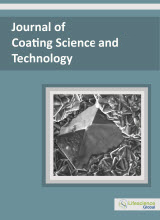jcst
Abstract : Corrosion Protection of Aluminum Alloy by Sol-Gel Derived Organic-Inorganic Hybrid Pretreatments Based on Epoxy Resin Modified Silane Precursor
|
|
|
Abstract: Organic-Inorganic hybrid (OIH) derived by sol-gel process have emerged as promising pretreatments alternative to conventional chromate-based systems for aluminum alloys. In this study novel organo-silane precursor has been synthesized from epoxy resin and amino-silane compound and used as the primary component of OIH film. The effects of epoxy and silane functionality and organic inhibitor used in the composition have been studied on corrosion resistance performance of aluminum alloy (3003-H14). The study also investigates the performance of top coat (powder coating) adhesion onto the pretreatment under different cure conditions. The chemical structure of sol-gel precursor (epoxy silane) and the deposited films have been characterized by FTIR analysis. The corrosion protection performance has been studied by electrochemical impedance spectroscopy (EIS), D.C. electrochemical polarization measurements, and the accelerated neutral salt spray test (ASTM B117). This study shows that by proper choice of precursor structure, functionality, processing conditions, and corrosion inhibitor amount, it is possible to derive OIH films with corrosion resistance performance comparable to conventional Cr (VI) based pretreatments. Keywords: Sol-gel, organic-inorganic hybrid, epoxy silane, corrosion inhibitor, aluminum alloy. |
Abstract : Coalescence of Water Drops in Water-ULSD Dispersions via Electrowetting
|
|
|
Abstract: Coalescence of water droplets is an important phenomenon in many industrial applications. One approach for coalescing water droplets is by applying an external voltage across the drops. Coalescence occurs when spreading and motion of the drops due to the electrical field brings the drops into contact. Electrowettable surfaces were prepared with poly(styrene-co-methyl methacrylate) as the dielectric film and Fluropel™ as the hydrophobic surface layer. The surface of a stainless steel disk was coated in a way that the dielectric coating layer thickness varied with radial position with minimum thicknesses at the center and at the outer edge of the disk and a maximum at an intermediate radial position of the disk surface. The thickness gradient influenced the droplet movement and contributed to the coalescence. Two disks were assembled with a thin slit between the disks. Emulsions of water droplets in ultra low sulfur diesel fuel were pumped through the thin slit. Experiments showed significant increase in drop sizes when the disks were electrified compared to non-electrified disks. Keywords: Electrowetting, Coalescence, Emulsion, Dispersion, Oil-Water. |
Abstract : Optical Coatings as Mirrors for Optical Diagnostics
|
|
|
Abstract: The aim of this work was to provide a comprehensive insight concerning coated films which might be used for first mirrors in ITER. The influence of the mirror crystallite size has been addressed as well as the coating techniques to provide nanocrystalline films. Tests of coated mirrors both in laboratories and in tokamaks are reviewed. For the tokamak tests a wide angle camera system has been installed in JET-ILW which is composed of a mirror box with 3 stainless steel mirrors coated with rhodium viewing the torus through a conically shaped aperture. The system delivered the required image quality for plasma monitoring and wall protection. No or insignificant degradation of the optical transmittance has been observed during the experimental campaign in 2014 with about 3000 plasma pulses in different magnetic field configurations. Keywords: First Mirrors, ITER, Mo, Rh coating, JET wide angle viewing system. |
Abstract : Synthesis of Cobalt Nanowires on Porous Anodic Alumina Template Using Electrochemical Deposition
|
|
|
Abstract: Electrochemical deposition has been widely used for synthesis of metal nanowires (NWs) on the porous template. In this paper, the effect of potential and electrolyte concentration on cobalt (Co) NWs formation through porous anodic alumina template has been investigated using direct-current electrodepostion at 0.75~2 V together with the high 0.5 M and low 0.1 M cobalt sulfurate based electrolyte. Scanning electron microscopy and grazing incidence X-ray diffraction were used to examine the nanostructure, morphology and phase of Co NWs. The current vs time curve was recorded for understanding the growth behavior. Too low potential of 0.75 V is not favored for Co NWs formation due to insufficient driving force while too high potential of 2 V ruins the NWs growth owing to hydrogen generation in reduction reaction. The uniform crystalline Co NWs can be obtained by the proper potential of 1V and concentration of 0.5 M at an average growth rate of 964 nm/min.
Keywords: Anodic alumina, electrochemical deposition, cobalt nanowires, porous template. |























